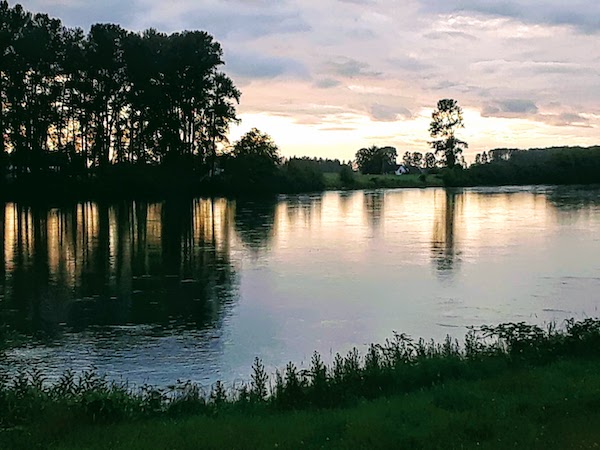Tales From the Magic Skagit: Come on Home to Green River

Well, take me back down
Where cool water flows, yeah.
Let me remember things I love,
Stoppin’ at the log where catfish bite,
Walkin’ along the river road at night,
Barefoot girls dancin’ in the moonlight.
I can hear the bullfrog callin’ me.
Wonder if my rope’s still hangin’ to the tree.
Love to kick my feet ‘way down the shallow water.
Shoefly, dragonfly, get back t’your mother.
Pick up a flat rock, skip it across Green River.
Well!
Up at Cody’s camp I spent my days, oh,
With flat car riders and cross-tie walkers.
Old Cody, Junior took me over,
Said, “You’re gonna find the world is smould’rin’.
And if you get lost come on home to Green River.”
Well!
Come on home.
– John Fogerty
Green River was a good song, although it wasn’t my favorite from that hit machine of the late ‘60s known as Creedence Clearwater Revival. As far as I’m concerned, the band’s nadir was Bayou Country.
Still, love it or not, you know a song is renting space in your psyche when a certain experience triggers the replay button on your Golden Oldies sound tract. And I’m not ashamed to say that pretty much every time I gaze on a wide, lazy river flowing through some bucolic landscape, Green River comes to mind. The other song that comes to mind is that one by the Doobie Brothers. You know the one I’m talking about. Anyway, thanks to living in the Skagit Valley, the magic portal to the muse that could have inspired CCR’s hit is less than 4.5 miles from my driveway, on a pull-out at the intersection of Dike and West Stackpole Roads.

From where I live it’s west on Blackburn past the Mount Vernon Christian School, then left on Britt Road with its scattering of genteel country homes interspersed with wetlands full of cattails, and lily pads large enough for a fairy hoedown. Take a left on Dike Road, heading south, and you follow the course of the mighty Skagit River, past more the more serious agricultural endeavors of family farms cultivating acres of potatoes, raising vegetable gardens, and tending alpacas. Most of the buildings clearly date back to when the first waves of European immigrants washed up on the shores of the Skagit River, and many of them have been lovingly preserved in all their 19th Century glory.

Further west, off Hickkox Road, you’ll likely smell the dairy farms before you see them. For some odd reason, I like the dairy farm smell better when I’m right up next to it than when it comes wafting up toward Little Mountain on damp winds out of the west. It reminds me of my grandparents’ farm in Ohio.
Speaking of dairy farms, if you travel far enough on Dike Road, not far from Conway, you’ll drive past one of the oldest ones in the area. A few years ago its barn was transformed into a state-of-the-art indoor cannabis cultivator, operated by the dairy’s descendants under the name Freya Farm — a reference to the goddess of Norse legend (a former Queen of the Valkyries, no less), and an obvious nod to the Scandinavian roots of the immigrant founders. Only in the Magic Skagit can a family farm go from milking bovines to clipping buds.

But your pull-out is at least a mile before you reach Freya Farm, at the corner of West Stackpole Road. You can’t miss it as you round a bend that follows the river. A quick 20 foot or so graveled scramble past a motor vehicle barrier, and you’re on the Dike Path.
If you live in Mount Vernon, your mental image of the Skagit River might be from crossing over it on the West Division Street Bridge, or strolling alongside it on the Riverwalk downtown. The latter is the better way to experience the tranquil splendor of the body of water that put Mount Vernon on the map, and to which access was hard purchased through a log removal project that would have been worthy of the Civilian Conservation Corps some decades later.

But if you want to experience the Skagit River the way the good Lord intended, further from the urban trappings of humankind, you need to get up on the Dike Path. If you ignore the obvious signs of habitation on its east side and face the sun’s descent, you’ll see the same sight our pioneer predecessors beheld when they settled down to make a living from the rich earth of the Skagit Valley’s bottom land, watered by snow fed waters of the Cascades as they flow to the Skagit Sound.

In this summer of our COVID-19 discontent, one of the great advantages of living where we do is that social distancing is a no-brainer — and walking exercises the large skeletal muscles of your body that produce immunoprotective compounds called myokines during exercise. But you don’t really need a health lecture to be awed by the river vistas that unfold as you walk the Dike Path — and it’s a different show every hour, every day, every season.

It’s a crazy world we’re living in, people, and it’s easy to feel stranded on the lee shore as we’re buffeted by bad news and dashed hopes. But you can always come on home to Green River. It’s waiting for you along the Dike Path, down among the trees…and deep in the heart of the Magic Skagit. Go take a walk.





